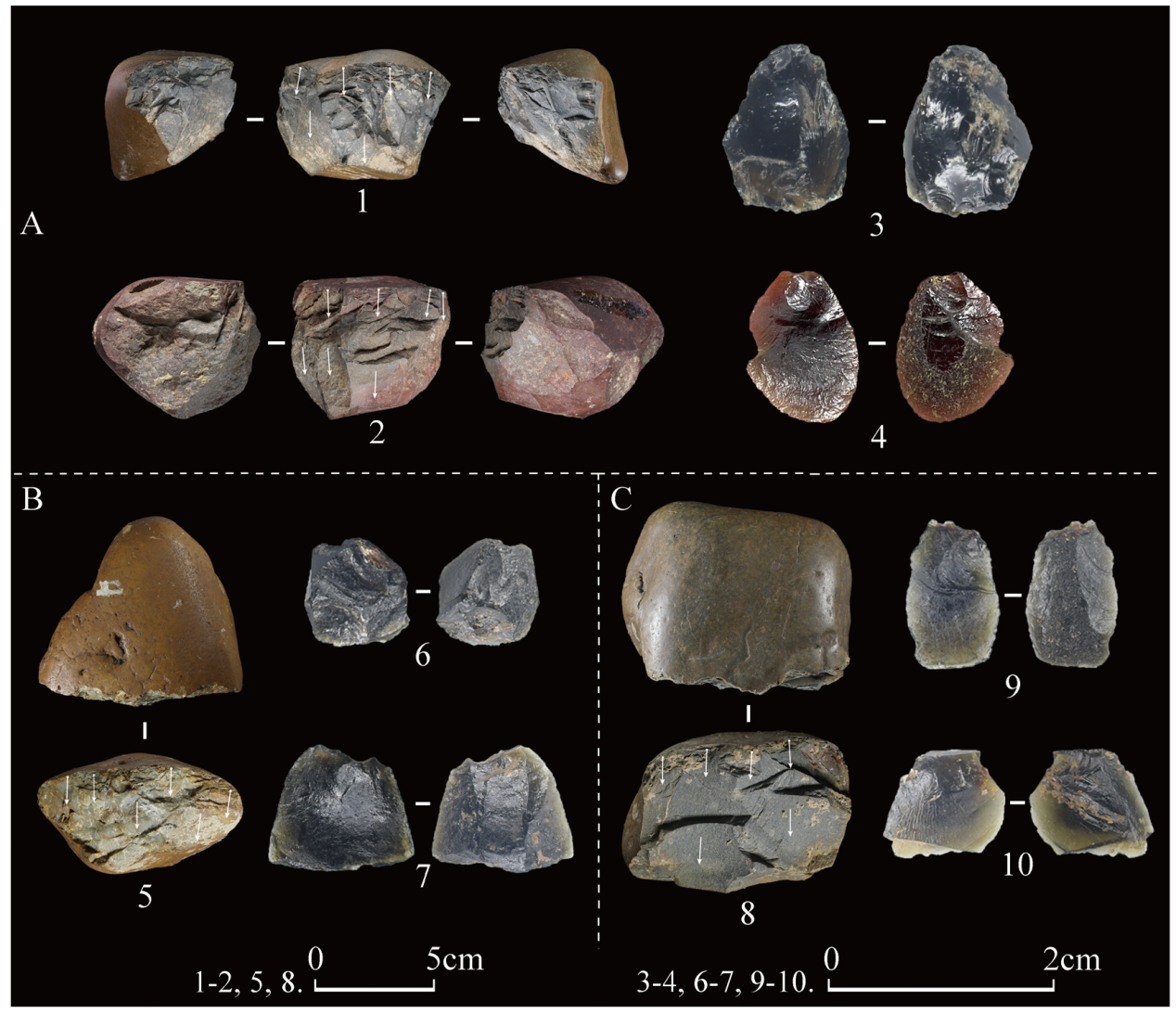

广西娅怀洞遗址B区出土的旧石器
收稿日期: 2024-11-06
修回日期: 2025-05-19
网络出版日期: 2025-06-18
基金资助
国家社会科学基金重大项目(22&ZD246)
Paleolithics excavated from Area B of the Yahuai Cave site, Guangxi
Received date: 2024-11-06
Revised date: 2025-05-19
Online published: 2025-06-18
娅怀洞遗址是近年来中国南方地区发现的一处文化内涵丰富、时代跨度较大的旧石器时代晚期到新石器时代遗址。遗址包含三个时期的旧石器文化层。对打制石制品的分析显示,遗址中并存两套特征鲜明的剥片系统:以砂岩和石灰岩为原料的陡刃锤击石核剥片系统,以及以玻璃陨石、燧石、石英、水晶为原料的砸击剥片系统。砸击技术主要用来生产小型石片和石片石器。该遗址以砸击技术为特色的小型石制品组合在东南亚、南亚,以及我国南北方不同地区的旧石器时代晚期遗址中均有发现,很可能指示了早期现代人跨区域迁徙扩散的过程。研究娅怀洞遗址旧石器时代石制品,为揭示中国南方地区早期现代人的技术与文化面貌,以及深入认识东亚早期现代人行为多样性和复杂性提供了重要材料和证据。

李浩 , 谢光茂 , 李大伟 , 李三灵 , 肖培源 , 陈清懿 , 王雨晴 , 贾真秀 , 吴雁 , 卢杰英 . 广西娅怀洞遗址B区出土的旧石器[J]. 人类学学报, 2025 , 44(03) : 404 -412 . DOI: 10.16359/j.1000-3193/AAS.2025.0047
The Yahuai Cave site is a newly discovered Late Paleolithic to Neolithic site in South China. The site has yielded rich cultural remains spanning a relatively long period. Three Paleolithic cultural phases have been identified from the site. Analysis of lithic assemblages shows that two distinctive flaking systems co-existed at the site. One is featured by the steep-angled flaking cores made on sandstone, while the other is featured by the bipolar flaking cores made on tektite, chert, quartz and crystal. Bipolar technology is mainly related to the production of miniaturized flakes and flake tools. Miniaturized lithic assemblages or minialithic technology have been widely documented in the Upper Paleolithic sites in South and Southeast Asia, as well as the different regions of China, likely indicating the migration and dispersal process of early modern humans. The study of knapped stone artifacts at Yahuai Cave provides important materials and evidence for understanding the behavioral diversity and complexity of early modern humans in East Asia.

Key words: Late Paleolithic; tektite; bipolar technology; minialithic; early modern humans
| [1] | Liu W, Jin CZ, Zhang YQ, et al. Human remains from Zhirendong, South China, and modern human emergence in East Asia[J]. Proceedings of the National Academy of Sciences, 2010, 107(45): 19201-19206 |
| [2] | Bae CJ, Wang W, Zhao J, et al. Modern human teeth from late Pleistocene Luna cave (Guangxi, China)[J]. Quaternary International, 2014, 354: 169-183 |
| [3] | Ge J, Xing S, Grün R, et al. New Late Pleistocene age for the Homo sapiens skeleton from Liujiang southern China[J]. Nature Communications, 2024, 15(1): 3611 |
| [4] | 谢光茂, 余明辉, 卢杰英. 广西隆安娅怀洞遗址发掘报告[J]. 人类学学报, 2025, 44(3): 365-388 |
| [5] | 广西柳州白莲洞洞穴科学博物馆. 柳州白莲洞[M]. 北京: 科学出版社, 2009 |
| [6] | 关莹, 蔡回阳, 王新金, 等. 贵州毕节老鸦洞遗址1985年出土的石制品[J]. 人类学学报, 2017, 36(3): 304-317 |
| [7] | 黄泗亭, 龙凤骧, 安家瑗. 马鞍山南洞旧石器文化遗址试掘报告[J]. 人类学学报, 1992, 11(1): 1-10 |
| [8] | 赵文杰, 贾真秀, 李三灵, 等. 2020年江西高安上湖旧石器遗址发掘报告[J]. 人类学学报, 2023, 42(3): 373-380 |
| [9] | 王幼平, 汪松枝. MIS3阶段嵩山东麓旧石器发现与问题[J]. 人类学学报, 2014, 33(3): 304-314 |
| [10] | 王幼平. 华北细石器技术的出现与发展[J]. 人类学学报, 2018, 37(4): 565-576 |
| [11] | Wang FG, Yang SX, Ge JY, et al. Innovative ochre processing and tool use in China 40,000 years ago[J]. Nature, 2022, 603(7900): 284-289 |
| [12] | 王幼平. 华北晚更新世的石片石器[J]. 人类学学报, 2019, 38(4): 525-535 |
| [13] | Marwick B. The Hoabinhian of Southeast Asia and its relationship to regional Pleistocene lithic technologies[A]. In: RobinsonE, SelletFEds. Lithic Technological Organization and Paleoenvironmental Change. Studies in Human Ecology and Adaptation[C]. Springer, 2018, 63-78 |
| [14] | Curnoe D, Datan I, Taçon PSC, et al. Deep skull from Niah Cave and the Pleistocene peopling of Southeast Asia[J]. Frontiers in Ecology and Evolution, 2016, 4: 75 |
| [15] | Détroit F, Dizon E, Falguères C, et al. Upper Pleistocene Homo sapiens from the Tabon cave (Palawan, The Philippines): description and dating of new discoveries[J]. Comptes Rendus Palevol, 2004, 3(8): 705-712 |
| [16] | Storm P, Wood R, Stringer C, et al. U-series and radiocarbon analyses of human and faunal remains from Wajak, Indonesia[J]. Journal of human evolution, 2013, 64(5): 356-365 |
| [17] | Aubert M, Brumm A, Ramli M, et al. Pleistocene cave art from Sulawesi, Indonesia[J]. Nature, 2014, 514(7521): 223-227 |
| [18] | O’Connor S, Ono R, Clarkson C. Pelagic fishing at 42,000 years before the present and the maritime skills of modern humans[J]. Science, 2011, 334(6059): 1117-1121 |
| [19] | Clarkson C, Harris C, Li B, et al. Human occupation of northern India spans the Toba super-eruption- 74,000 years ago[J]. Nature Communications, 2020, 11(1): 961 |
| [20] | Clarkson C, Petraglia M, Korisettar R, et al. The oldest and longest enduring microlithic sequence in India: 35 000 years of modern human occupation and change at the Jwalapuram Locality 9 rockshelter[J]. Antiquity, 2009, 83(320): 326-348 |
| [21] | Wedage O, Picin A, Blinkhorn J, et al. Microliths in the South Asian rainforest- 45-4 ka: New insights from Fa-Hien Lena Cave, Sri Lanka[J]. PloS One, 2019, 14(10): e0222606 |
| [22] | 邓聪. 越南Nguoum遗址之学习纪要[J]. 见:英德市博物馆,中山大学人类学系,广东省博物馆(编). 中石器文化及有关问题研讨会论文集[J]. 广州: 广东人民出版社, 1999 |
| [23] | 周玉端. 柳州白莲洞遗址石器工业的技术分析[J]. 硕士研究生毕业论文, 武汉: 武汉大学, 2017 |
| [24] | 邓婉文, 刘锁强, 巫幼波, 等. 广东英德青塘遗址黄门岩2号洞地点2016年度的发掘[J]. 人类学学报, 2020, 39(1): 64-73 |
/
| 〈 |
|
〉 |